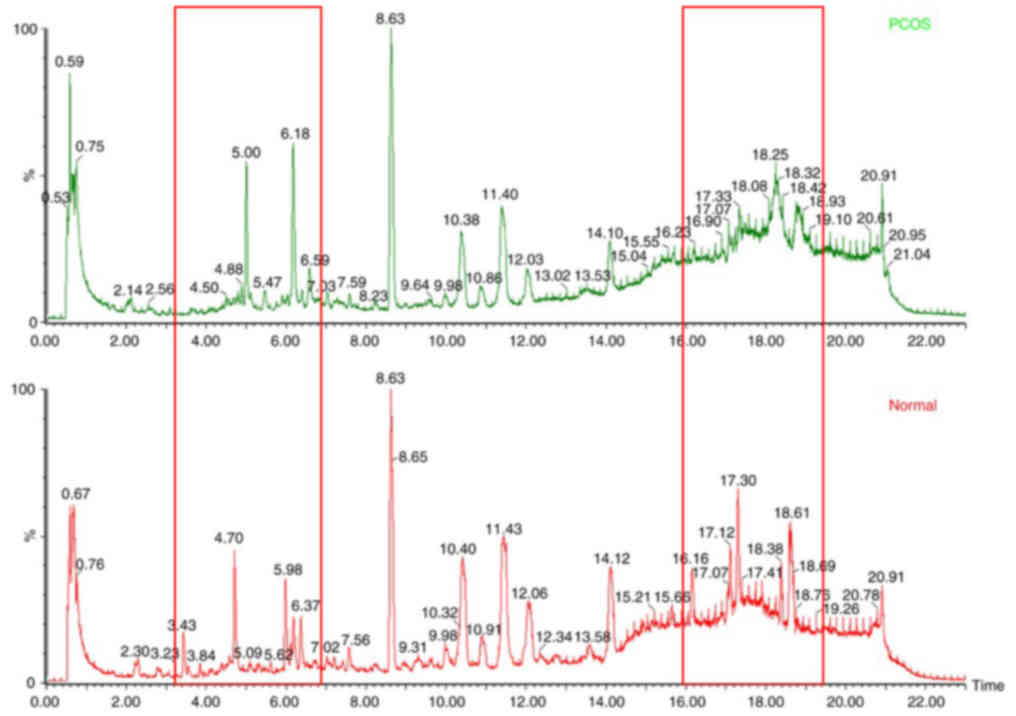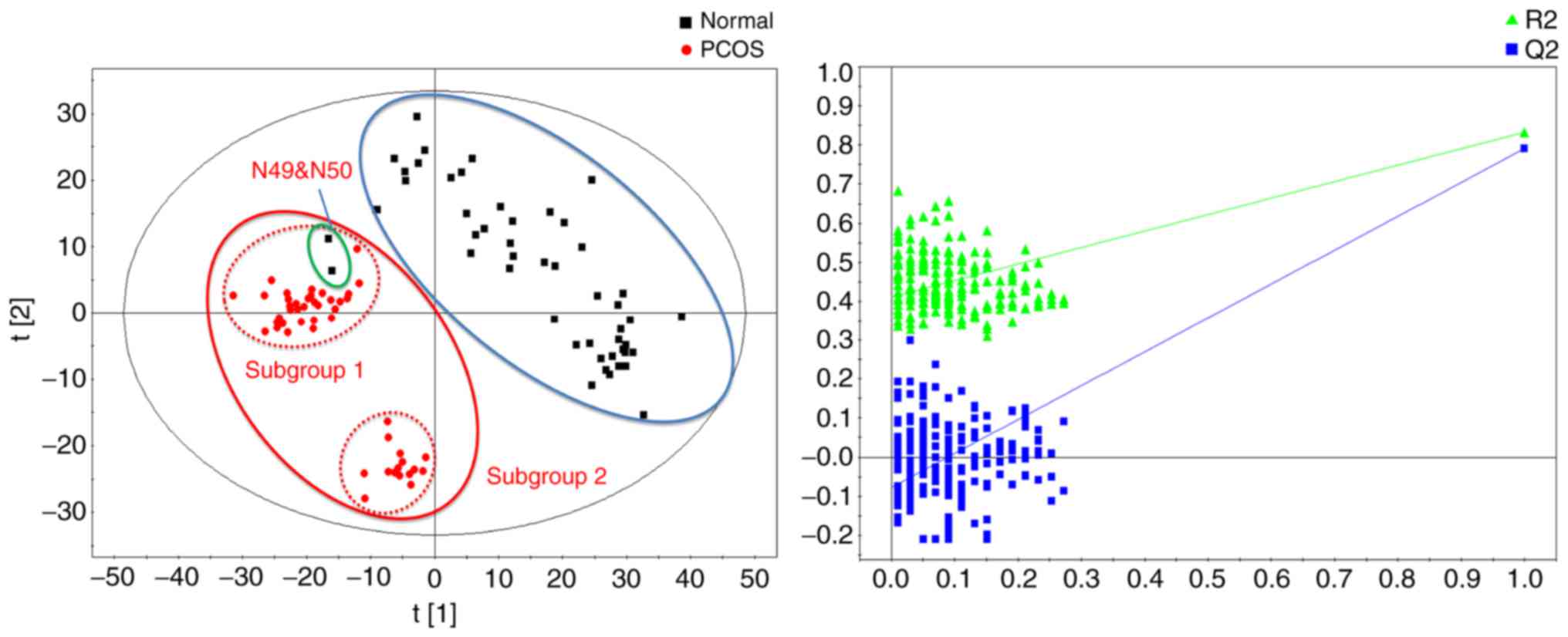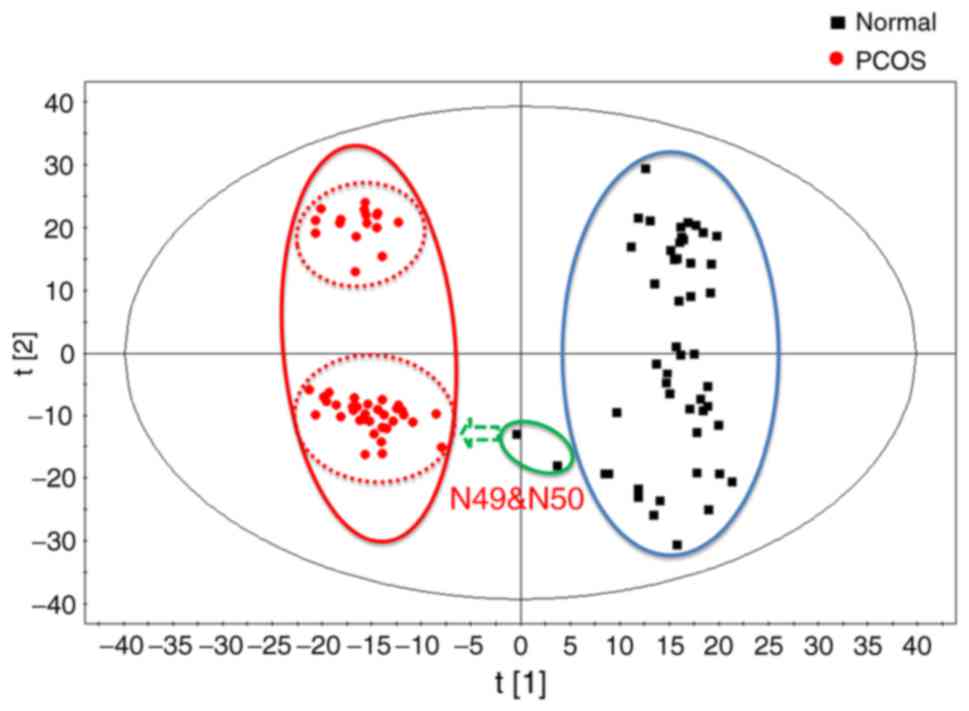|
1
|
Glintborg D and Andersen M: An update on
the pathogenesis, inflammation, and metabolism in hirsutism and
polycystic ovarysyndrome. Gynecol Endocrinol. 26:281–296. 2010.
View Article : Google Scholar : PubMed/NCBI
|
|
2
|
Azziz R, Carmina E, Dewailly D,
Diamanti-Kandarakis E, Escobar-Morreale HF, Futterweit W, Janssen
OE, Legro RS, Norman RJ, Taylor AE, et al: Positions statement:
Criteria for defining polycystic ovary syndrome as a predominantly
hyperandrogenic syndrome: An androgen excess society guideline. J
Clin Endocrinol Metab. 91:4237–4245. 2006. View Article : Google Scholar : PubMed/NCBI
|
|
3
|
Knebel B, Janssen OE, Hahn S, Jacob S,
Gleich J, Kotzka J and Muller-Wieland D: Increased low grade
inflammatory serum markers in patients with polycystic ovary
syndrome (PCOS) and their relationship to PPARgamma gene variants.
Exp Clin Endocrinol Diabet. 116:481–486. 2008. View Article : Google Scholar
|
|
4
|
Lerchbaum E, Schwetz V, Giuliani A and
Obermayer-Pietsch B: Influence of a positive family history of both
type 2 diabetes and PCOS on metabolic and endocrine parameters in a
large cohort of PCOS women. Eur J Endocrinol. 170:727–739. 2014.
View Article : Google Scholar : PubMed/NCBI
|
|
5
|
Zhao S, Tian Y, Gao X, Zhang X, Liu H, You
L, Cao Y, Su S, Chan WY, Sun Y, et al: Family-based analysis of
eight susceptibility loci in polycystic ovary syndrome. Sci Rep.
5:126192015. View Article : Google Scholar : PubMed/NCBI
|
|
6
|
Kume T, Calan M, Yilmaz O, Kocabas GU,
Yesil P, Temur M, Bicer M and Calan OG: A possible connection
between tumor necrosis factor alpha and adropin levels in
polycystic ovary syndrome. J Endocrinol Invest. 39:747–754. 2016.
View Article : Google Scholar : PubMed/NCBI
|
|
7
|
Chen YX, Zhang XZ, Huang J, Zhou SJ, Liu
F, Jiang LL, Chen M, Wan JB and Yang DZ: UHPLC/Q-TOFMS-based plasma
metabolomics of polycystic ovary syndrome patients with and without
insulin resistance. J Pharm Biomed Anal. 121:141–150. 2016.
View Article : Google Scholar : PubMed/NCBI
|
|
8
|
Zhao Y, Fu L, Li R, Wang LN, Yang Y, Liu
NN, Zhang CM, Wang Y, Liu P, Tu BB, et al: Metabolic profiles
characterizing different phenotypes of polycystic ovary syndrome:
Plasma metabolomics analysis. BMC Med. 10:1532012. View Article : Google Scholar : PubMed/NCBI
|
|
9
|
Rautio K, Tapanainen JS, Ruokonen A and
Morin-Papunen LC: Rosiglitazon treatment alleviates inflammation
and improves liver function in overweight women with polycystic
ovary syndrome: A randomized placebo controlled study. Fertil
Steril. 87:202–226. 2007. View Article : Google Scholar : PubMed/NCBI
|
|
10
|
Baskind NE and Balen AH:
Hypothalamic-pituitary, ovarian and adrenal contributions to
polycystic ovary syndrome. Best Pract Res Clin Obstet Gynaecol.
37:80–97. 2016. View Article : Google Scholar : PubMed/NCBI
|
|
11
|
Lian Y, Zhao F and Wang W: Central leptin
resistance and hypothalamic inflammation are involved in
letrozole-induced polycystic ovary syndrome rats. Biochem Biophys
Res Commun. 476:306–312. 2016. View Article : Google Scholar : PubMed/NCBI
|
|
12
|
Cheng F, Zhao L, Wu Y, Huang T, Yang G,
Zhang Z, Wu Y, Jia F, Wu J, Chen C and Liu D: Serum vascular
endothelial growth factor B is elevated in women with polycystic
ovary syndrome and can be decreased with metformin treatment. Clin
Endocrinol (Oxf). 84:386–393. 2016. View Article : Google Scholar : PubMed/NCBI
|
|
13
|
Atiomo W and Daykin CA: Metabolomic
biomarkers in women with polycystic ovary syndrome: A pilot study.
Mol Hum Reprod. 18:546–553. 2012. View Article : Google Scholar : PubMed/NCBI
|
|
14
|
Sun LY, Hu WH, Liu Q, Hao Q, Sun B, Zhang
Q, Mao S, Qiao J and Yan X: Metabonomics reveals plasma metabolic
changes and inflammatory marker in polycystic ovary syndrome
patients. J Proteome Res. 11:2937–2946. 2012. View Article : Google Scholar : PubMed/NCBI
|
|
15
|
Zhao XJ, Xu F, Qi B, Hao S, Li Y, Li Y,
Zou L, Lu C, Xu G and Hou L: Serum metabolomics study of polycystic
ovary syndrome based on liquid chromatography-mass spectrometry. J
Proteome Res. 13:1101–1111. 2014. View Article : Google Scholar : PubMed/NCBI
|
|
16
|
Rotterdam ESHRE/ASRM-Sponsored PCOS
Consensus Workshop Group: Revised 2003 consensus on diagnostic
criteria and long-term health risks related to polycystic ovary
syndrome. Fertil Steril. 81:19–25. 2004. View Article : Google Scholar
|
|
17
|
Lujan ME, Chizen DR and Pierson RA:
Diagnostic criteria for polycystic ovary syndrome: Pitfalls and
controversies. J Obstet Gynaecol Can. 30:671–679. 2008. View Article : Google Scholar : PubMed/NCBI
|
|
18
|
Xue YJ, Xie H, Sun ML, et al:
Characteristics of abnormal lipid metabolism in PCOS patients with
insulin resistance. Chin J Mod Med. 24:94–98. 2014.(In
Chinese).
|
|
19
|
Yilmaz M, Biri A, Bukan N, Karakoç A,
Sancak B, Törüner F and Paşaoğlu H: Levels of lipoprotein and
homocysteine in non-obese and obese patients with polycystic ovary
syndrome. Gynecol Endocrinol. 20:258–263. 2005. View Article : Google Scholar : PubMed/NCBI
|
|
20
|
Padmapriya B and Kesavamurthy T: Detection
of follicles in poly cystic ovarian syndrome in ultrasound images
using morphological operations. J Med Imaging Health Inform.
6:240–243. 2016. View Article : Google Scholar
|
|
21
|
Walch K, Grimm C, Zeillinger R, Huber JC,
Nagele F and Hefler LA: A common interleukin-6 gene promoter
polymorphism influences the clinical characteristicsof women with
polycystic ovary syndrome. Fertil Steril. 81:1638–1641. 2004.
View Article : Google Scholar : PubMed/NCBI
|
|
22
|
Vgontzas AN, Trakada G, Bixler EO, Lin HM,
Pejovic S, Zoumakis E, Chrousos GP and Legro RS: Plasma interleukin
6 levels are elevated in polycystic ovary syndrome independently
ofobesity or sleep apnea. Metabolism. 55:1076–1082. 2006.
View Article : Google Scholar : PubMed/NCBI
|
|
23
|
Verit FF: High sensitive serum C-reactive
protein and its relation-ship with other cardiovascular risk
factors in normoinsulinemic polycystic ovary patients without
metabolic syndrome. Arch Gynecol Obstet. 281:1009–1014. 2010.
View Article : Google Scholar : PubMed/NCBI
|
|
24
|
Dong F, Deng D, Chen H, Cheng W, Li Q, Luo
R and Ding S: Serum metabolomics study of polycystic ovary syndrome
based on UPLC-QTOF-MS coupled with a pattern recognition approach.
Anal Bioanal Chem. 407:4683–4695. 2015. View Article : Google Scholar : PubMed/NCBI
|
|
25
|
Martina V, Benso A, Gigliardi VR, Masha A,
Origlia C, Granata R and Ghigo E: Short-term dehydroepiandrosterone
treatment increases platelet cGMP production in elderly male
subjects. Clin Endocrinol (Oxf). 64:260–264. 2006. View Article : Google Scholar : PubMed/NCBI
|
|
26
|
Martina V, Origlia C, Bruno GA, Messina M,
Ferri M and Pescarmona GP: Serum DHEAS levels correlate with
platelet cGMP in normal women. J Endocrinol Invest. 24:RC28–RC30.
2001. View Article : Google Scholar : PubMed/NCBI
|
|
27
|
Holte J, Bergh T, Gennarelli G and Wide L:
The independent effects of polycystic ovary syndrome and obesity on
serum concentrations of gonadotrophins and sex steroids in
premenopausal women. Clin Endocrinol (Oxf). 41:473–481. 1994.
View Article : Google Scholar : PubMed/NCBI
|
|
28
|
Huang A, Brennan K and Azziz R: Prevalence
of hyperandrogenemia in the polycystic ovary syndrome diagnosed by
the National Institutes of Health 1990 criteria. Fertil Steril.
93:1938–1941. 2010. View Article : Google Scholar : PubMed/NCBI
|













